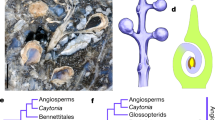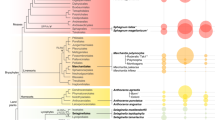Abstract
THE land masses destined to become Australia, Madagascar and the associated Mascarene Islands are thought to have separated from the old southern continent of Gondwanaland after the establishment of an angiosperm flora1. Similarities in the present floras of the areas, as exemplified by Cohnia and Cossinia which occur in Australia and New Caledonia but have their most westerly habitats in the Mascarene Islands, are consistent with this belief2. The legume genus Acacia which is widely represented in America, Africa, Asia, Australia and many oceanic islands is thought to have originated in what is now northern South America and to have spread through Gondwanaland3. A survey of non-protein amino acids in the seeds of 123 species of Acacia has shown that the genus is divisible into four discrete biochemically defined sub-genera4. All 67 species from Australia which were analysed showed a single characteristic amino acid pattern. This Australian pattern was found in only one non-Australian species. A. heterophylla (Lam.) Willd. a native of the Mascarene Islands and one of the few phyllodinous species found outside Australia. In this communication we suggest that the seed chemistry of A. heterophylla and of the Australian species is the seed chemistry which characterised the original Acacia species of Gondwanaland.
This is a preview of subscription content, access via your institution
Access options
Subscribe to this journal
Receive 51 print issues and online access
$199.00 per year
only $3.90 per issue
Buy this article
- Purchase on Springer Link
- Instant access to full article PDF
Prices may be subject to local taxes which are calculated during checkout
Similar content being viewed by others
References
Johnson, B. D., Powell, C. M. & Veevers, J. J. Bull. geol. soc., 87, 1560–1566 (1976).
Good, R. Blumea 6, 470–479 (1950).
Vassal, J. Trav. lab. Forestier de Toulouse 1, 8 (1972).
Evans, C. S., Qureshi, M. Y. & Bell, E. A. Phytochemistry 16, 565–570 (1977).
Bentham, G. Flora Australiensis 2, 301–421 (Lovell Reeve, London, 1864).
Olney, J. W., Misra, C. H. & Rhee, V. Nature 264, 659–661 (1976).
Murti, V. V. S., Seshadri, T. R. & Venkitasubramanian, T. A. Phytochemistry 3, 73–78 (1964).
Rao, S. L. N., Adiga, P. R. & Sarma, P. S. Biochemistry 3, 432–436 (1964).
Navon, A. & Bernays, E. A. Comp. Biochem. Physiol. 59A, 161–164 (1978).
Author information
Authors and Affiliations
Rights and permissions
About this article
Cite this article
BELL, E., EVANS, C. Biochemical evidence of a former link between Australia and the Mascarene Islands. Nature 273, 295–296 (1978). https://doi.org/10.1038/273295a0
Received:
Accepted:
Issue Date:
DOI: https://doi.org/10.1038/273295a0
Comments
By submitting a comment you agree to abide by our Terms and Community Guidelines. If you find something abusive or that does not comply with our terms or guidelines please flag it as inappropriate.



